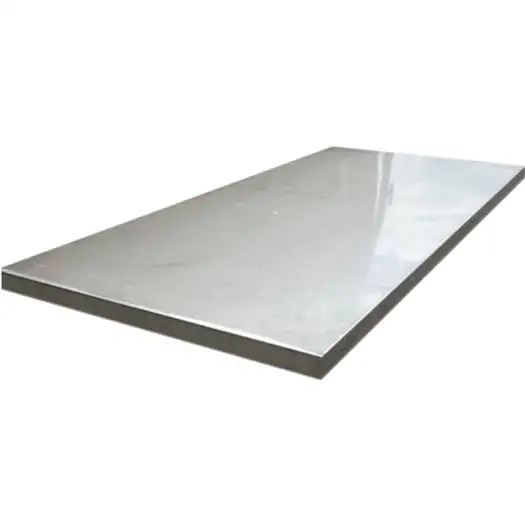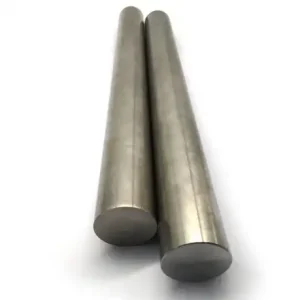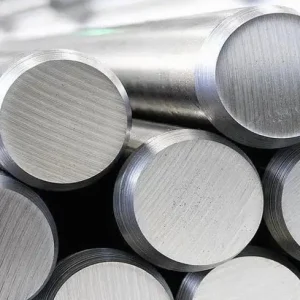Alloy 2507 (UNS S32750 / SAF® 2507 / EN 1.4410) is a super-duplex stainless steel plate that combines very high mechanical strength with exceptional resistance to pitting, crevice corrosion and chloride stress-corrosion cracking—making it the go-to choice for demanding seawater, offshore oil & gas, desalination and aggressive chemical process services. For buyers who need reliable supply, MWalloys offers factory-direct 2507 plate from China with competitive 100% factory pricing, routine stock levels for fast delivery, and full certification (material test reports / NDT / PMI available).
What is 2507 Duplex Stainless Steel?
Alloy 2507 is classified as a super-duplex stainless steel because its alloying (≈25% Cr, ≈4% Mo, ≈7% Ni plus elevated N) pushes its pitting resistance and strength well beyond standard duplex grades. The dual-phase microstructure (roughly 50/50 austenite/ferrite when correctly processed) gives it high yield strength (≈550 MPa / 80 ksi 0.2% proof) and tensile strength (~795–800 MPa / 116 ksi), enabling thinner, lighter components for pressure-containing and structural parts. Its PREN (Pitting Resistance Equivalent Number) is typically ≥40 for genuine 2507 material, explaining the superior pitting and crevice resistance in chloride environments.
Chemical composition
Note: suppliers publish narrow and nominal ranges; create project-specific chemical limits in the PO or spec (EN, ASTM) and verify on the MTR.
| Element | Typical / Specified range (wt.%) |
|---|---|
| Carbon (C) | ≤ 0.03 |
| Silicon (Si) | ≤ 1.0 |
| Manganese (Mn) | ≤ 1.2–2.0 |
| Phosphorus (P) | ≤ 0.03–0.035 |
| Sulfur (S) | ≤ 0.015 |
| Chromium (Cr) | 24.0 – 26.5 |
| Nickel (Ni) | 6.0 – 8.0 |
| Molybdenum (Mo) | 3.0 – 5.0 (typical ~3.5–4.0) |
| Nitrogen (N) | 0.24 – 0.32 (typical ~0.25) |
| Copper (Cu) | ≤ 0.5 |
| Iron (Fe) | Balance |
Sources and typical industrial datasheets corroborating the above numbers.
PREN (practical rule):
PREN ≈ %Cr + 3.3×%Mo + 16×%N. Typical 2507 PREN is ≥40, often >42, placing it in the “super-duplex” class and close to Zeron® or other high-PREN super duplex alloys. High PREN correlates with strong resistance to pitting and crevice corrosion in chloride-bearing media.
Mechanical properties
| Property | Typical min (plate, annealed) |
|---|---|
| Ultimate tensile strength (UTS) | ≥ 795–800 MPa (≈116 ksi) |
| 0.2% proof / yield strength | ≥ 550 MPa (≈80–116 ksi depending on source/test) |
| Elongation (% in 50 mm) | ≥ 15% |
| Hardness (Brinell) | ≤ 310 HB (approx.) |
| Impact / toughness | Good down to sub-zero temperatures (vendor data required per spec) |
Design note: the high proof strength makes 2507 suitable where weight savings (thinner sections) or higher pressure ratings are required versus austenitics. Confirm permitted design temperature and toughness for cryogenic service with supplier test data.
Standards, specifications & supply forms
Common specifications that cover 2507 / UNS S32750 material forms:
-
ASTM A240 / A240M — stainless steel plate, sheet, and strip for pressure vessels and general use (plate form commonly supplied per this standard).
-
ASTM A182 / A182M — forgings / flanges in alloy grades (where applicable).
-
ASTM A789 / A790 / A789 — tubular and pipe specifications that reference S32750 for seamless/welded pipe and tube.
-
EN 10088 / EN 1.4410 — European nomenclature X2CrNiMoN25-7-4, material no. 1.4410.
-
UNS S32750, F53 — common identifiers in vendor catalogs.
Supply forms: hot-rolled plate, cold-rolled strip, sheet, plate (various thicknesses), cut blanks, bars, seamless and welded pipe, welded tube, fittings and flanges. Thickness ranges from thin foil to >100 mm plate depending on mill capability.
What is equivalent to 2507?
-
UNS: S32750
-
EN/WNr: X2CrNiMoN25-7-4 / 1.4410
-
Trade names: SAF® 2507 (Sandvik/Alleima trademark), F53 (sometimes used)
-
Comparable grades: Zeron® 100 (UNS S32760) is a nearby super-duplex with somewhat different alloying and very high PREN; pick between them per application and availability.
How 2507 differs from duplex 2205 (practical comparison)
Summary: 2507 is a super-duplex with higher Cr, Mo and N versus the standard duplex 2205 (S31803 / S32205). The alloying shifts the balance to substantially better pitting, crevice and SCC resistance and a higher strength envelope — but at higher material cost and somewhat greater sensitivity in certain fabrication windows.
Key contrasts:
-
Corrosion resistance: 2507 typically achieves PREN ≥40 vs 2205 PREN ~34–36 — meaning appreciably better pitting/crevice resistance in chloride environments.
-
Strength: 2507 yields and tensile strengths are higher, enabling thinner sections or higher allowable stresses.
-
Weldability / fabrication: both are weldable but 2507 demands tighter control of heat input and interpass temps to maintain phase balance and avoid detrimental sigma/ferrite morphology—welding procedures and qualified welders are essential.
-
Cost & availability: 2205 is more common and usually less expensive; 2507 costs more due to higher alloying and sometimes more limited mill capacity—plan lead times accordingly.
Corrosion behaviour: pitting, crevice, SCC — practical guidance
-
Where 2507 excels: seawater intake systems, subsea equipment, desalination plants, ballast & fire-fighting systems, chemical reactors handling halide acids or chlorides, FGD (flue gas desulphurization) scrubbers and high-pressure heat exchangers. The combination of Mo + Cr + N provides superior localized corrosion resistance.
-
Design guidance: calculate PREN for your exact chemistry; use CPT (critical pitting temperature) data, and assess crevice geometries. Also consider environmental factors (temperature, chloride concentration, stagnant crevices).
-
SCC: duplex microstructure gives significantly better resistance to chloride SCC than many austenitics; still, avoid combinations of tensile stress + aggressive chloride at elevated temperatures without proper qualification.
Fabrication & welding notes
-
Machining: 2507 is harder than common austenitics — use rigid tooling, higher power machines, sharp carbide inserts, interrupted cut allowances, and conservative speeds with heavy feed. Coolant and chip evacuation are important.
-
Forming: cold forming is possible but limited compared with austenitic grades; hot forming (controlled) is used for larger deformations.
-
Welding: use matching filler (e.g., ER2594/ S32750 filler) and pre-qualified procedures; control interpass temperature (keep low), limit heat input, and perform post-weld solution anneal only when required by code (many fabrications are left in as-welded condition with PWHT avoided). Use qualified welders and test welds for phase balance and toughness where the application demands.
Typical applications & case examples
-
Oil & Gas / Offshore: risers, flowlines, subsea manifolds, connectors, clamps and seawater pumps.
-
Desalination: high-pressure RO housings, sea-water piping and heat exchangers.
-
Chemical process / Petrochemical: acid containment, hydrogen chloride service lines, amine systems (after compatibility review).
-
Power & Environmental: FGD scrubber ducts, absorber towers and piping in power plants.
-
Marine: seawater service valves, propeller shafts components, ballast systems.
Global price snapshot (2025)
Market note: alloy pricing moves with base steel market, Ni/Mo/Cr commodity prices, and mill production capacity. Quoted ranges below are collected from supplier catalogs and marketplace listings in 2025; always request an updated PI from vendors and confirm delivery/incoterms.
| Region | Representative 2025 indicative price (USD / metric ton) | Source / comment |
|---|---|---|
| China (factory stock / FOB China) | $1,200 – $4,500 / t (typical plate quotes vary widely by thickness/finish; many listings show $1,500–3,000/t; some premium/low MOQ offers higher). | Market listings & supplier pages |
| India (local stock + import parity) | $1,800 – $5,500 / t (depending on grade form, local demand and import duties). | Indian distributors & catalog entries |
| Europe (EU buyers, ex-works) | $3,000 – $7,000 / t (higher delivery and certification premium typical). | European distributors and price lists |
| USA (domestic + imported) | $3,000 – $6,500 / t (plate & sheet market with certification lead times; price spikes with alloy surcharges). | Marketplace listings & distributors |
How to read the table: these are indicative bands. Plate thickness, surface finish, mill test certificate level (EN 10204 3.1 vs 3.2), quantity, shipping method and certification needs (NACE, AD2000, PED) materially affect price. Always obtain a formal PI stating alloy, spec (ASTM/EN), thickness, length, surface, MTR, heat number traceability, and delivery INCOTERM.
Procurement & inspection checklist (what to require from supplier)
When buying 2507 plate, ask the supplier for:
-
Exact material designation (UNS S32750 / EN 1.4410 / SAF 2507).
-
Mill Test Report (MTR) EN 10204 3.1 (or 3.2 if required) showing chemical analysis and mechanical tests.
-
Heat number traceability and dimensions/tolerance report (thickness planarity).
-
NDT reports if requested: ultrasonic or surface inspection.
-
Welding filler and procedure recommendations and any pre-qualified WPS if large fabrications are involved.
-
PMI (positive material identification) on arrival if project requires verification.
-
Delivery lead time and shipping terms (FOB, CIF, DDP).
Why MWalloys: MWalloys stocks 2507 plate in China and supplies factory-direct pricing with rapid stock shipments; we provide complete MTRs, PMI support on request and can assist with customized cutting, edge-conditioning and export documentation to speed project schedules.
Quality control, testing & in-service monitoring
Key tests to demand for critical applications:
-
Chemical analysis (MTR)
-
Tensile & proof strength tests
-
Hardness
-
Impact testing (where low temperature toughness is required)
-
Pitting/crevice resistance data (CPT testing can be performed for severe services)
-
Welded coupon testing (e.g., ferrite measurement, microstructure checks)
-
PMI (OES or XRF) on receipt for trace verification
Monitoring in service: schedule corrosion inspections, crevice access inspection, and consider electrical isolation of dissimilar metals to avoid galvanic attack.
FAQs
-
Is 2507 magnetic?
Yes — like other duplex steels it shows magnetic response because of the ferritic phase; however, it is less magnetic than fully ferritic grades. -
Can 2507 be welded to 2205 or 316?
Yes with matched weld fillers and controlled procedures; avoid mixing without metallurgical review, and ensure qualified WPS and post-weld tests. -
What temperature limits apply for 2507?
Service temperature limits depend on application; avoid prolonged service above ~300–350°C where embrittlement risks increase—use material data sheets and client engineering rules. -
Is 2507 suitable for seawater pumps?
Yes — widely used for seawater pumps, shafts, and heat exchangers when high pitting resistance is required. -
What certificates should I get?
At minimum: EN 10204 3.1 MTR, dimensional report, and NDT if specified. For critical service, request 3.2 or independent inspection. -
How does cost compare with 316 or 2205?
2507 is more costly than 316 and 2205 on a per-kg basis, but higher strength can reduce component weight and life-cycle costs—run a life-cycle analysis. -
What is PREN and why is it important?
PREN estimates pitting resistance. For chloride service, higher PREN correlates with better localized corrosion resistance—aim for PREN ≥40 for aggressive seawater exposure. -
Can 2507 be hardened by heat treatment?
Duplex steels are not hardened like martensitic steels; strength and properties rely on controlled anneal/solution treatments and phase balance. Avoid improper heat exposure that produces sigma phase. -
Lead time and MOQ typical from Chinese mills?
Milled plates often require batch runs—stocked sizes can ship in days to weeks; custom large plates or certified lots may take longer. MWalloys maintains stock for many sizes to shorten delivery. (Contact for exact lead time.) -
Is there a stainless alloy surcharge?
Yes—surcharges (Ni/Mo/Cr) change with commodity markets; include allowance for surcharges in long-term procurement budgets.
Buying recommendation
-
Specify UNS S32750 / EN 1.4410 and required standard (ASTM/EN) in PO.
-
Demand EN 10204 3.1 MTR and PMI at arrival for verification.
-
Ask supplier for heat-numbered test reports and photos of mill certificates.
-
For welding, request matching filler metal and qualified weld procedure specification (WPS).
-
For aggressive service, request CPT / PREN documentation from mill or independent lab.
-
Obtain firm price and lead time including alloy surcharge breakdown and shipping INCOTERM.
MWalloys offers tailored quotations, cutting-to-size, and assistance with documentation and shipping — contact our sales team with project specs and we will provide a PI within business hours.
Final technical tips
-
Always run a PREN calculation for your exact delivered chemistry.
-
For critical pressure boundaries, require impact testing and weld procedure qualification.
-
Treat 2507 as a premium material: specification, inspection and documented traceability matter more than for commodity steels.
-
If in doubt about in-service environment (chloride, H2S, temperature), consult a corrosion engineer and request CPT or exposure tests.





